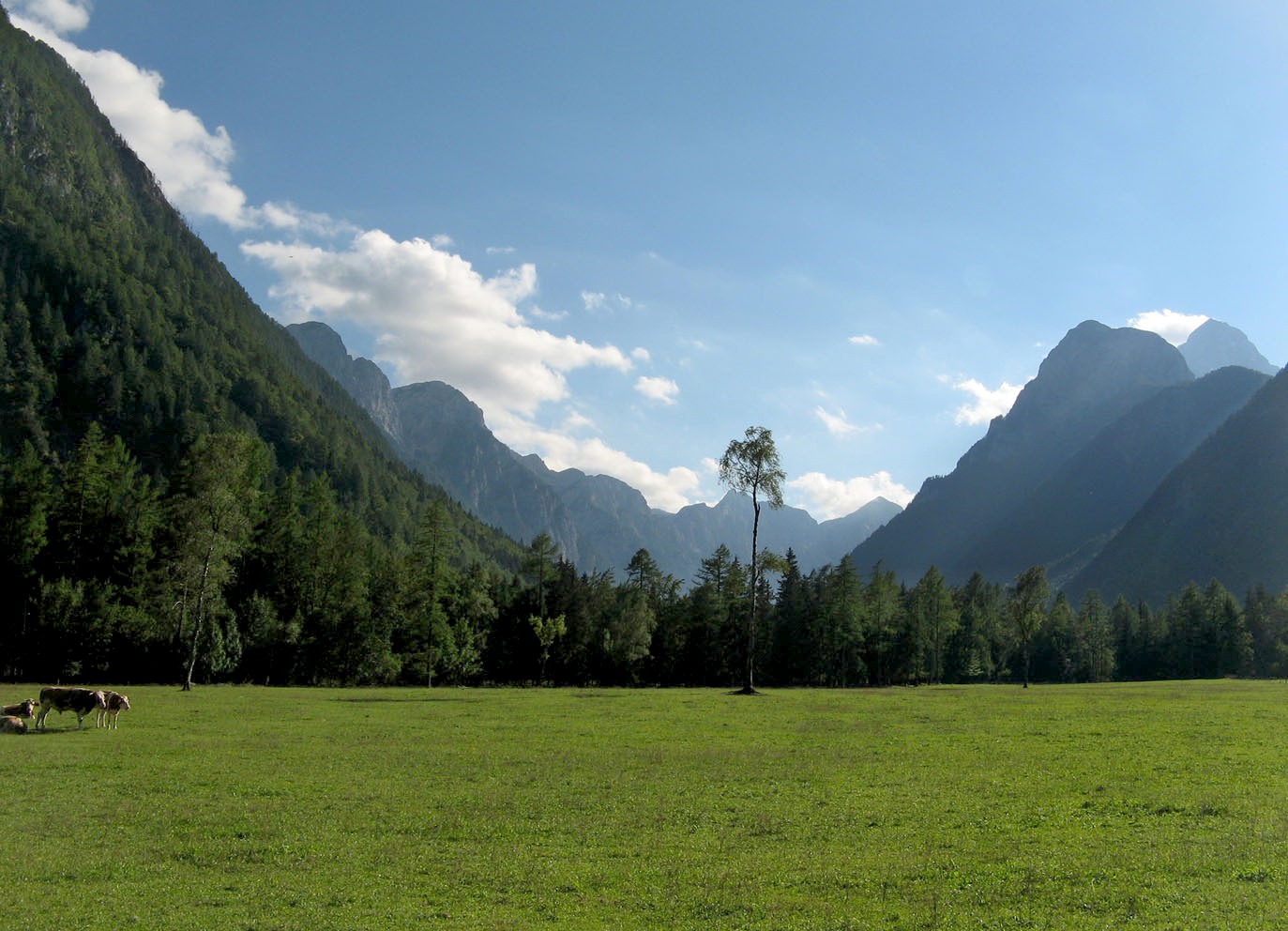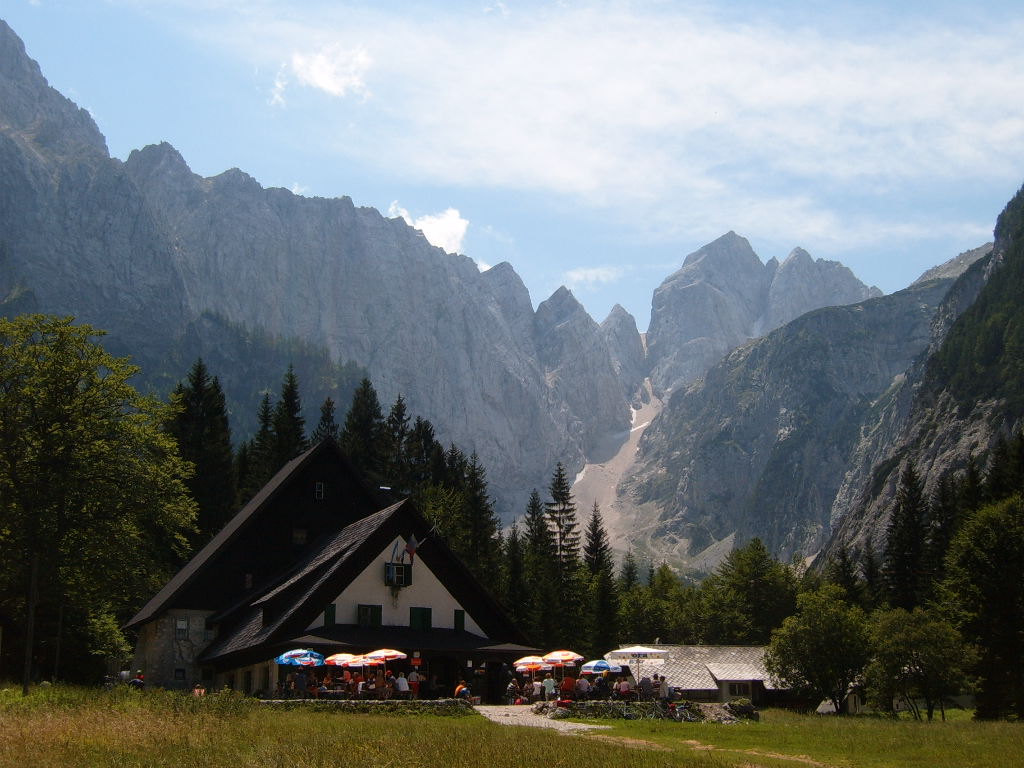|
Krma
Krma is an alpine valley in the Julian Alps in the Upper Carniola region of northwestern Slovenia. The entire valley lies in Triglav National Park. Name The name ''Krma'' is of uncertain origin, possibly derived from a substrate root such as *''karma'' or *''garma'', which may be preserved in Istrian Romance ''karma'' 'rock crevice'; it is less likely to be related to Albanian ''karmë'' 'rocky hill'. It cannot be excluded that the name may also be connected with the Slovene common noun ''krma'' 'fodder' because of historical pasturing activity in the valley. Geography Krma is the longest and easternmost of the glacial valleys near Mojstrana. It is the starting point for many routes through Triglav National Park. The lower northern end of the Krma Valley intersects with the upper western end of the Radovna Valley. Approximately two-thirds of the way up the valley is the Kovinar alpine lodge (elevation: ) with 15 berths, a popular stopping point for hikers. This lodge was orig ... [...More Info...] [...Related Items...] OR: [Wikipedia] [Google] [Baidu] |
Mojstrana
Mojstrana (; german: Meistern) is a village in the Municipality of Kranjska Gora in the Upper Carniola region of Slovenia. Geography Mojstrana is located in the Upper Sava Valley at the point where Bistrica Creek joins the Sava River below the main road from Jesenice to Kranjska Gora at an elevation of 641 m. The glacial Vrata Valley leads from Mojstrana towards the southwest past Peričnik Falls to the north face of Mount Triglav. The road to three other valleys— Radovna, Krma, and Kot—also begins in Mojstrana. Name Mojstrana was first attested in 1763–87 as ''Moistrana''. The suffix ''-ana'' indicates that the name is of Romance or pre-Romance origin. The root ''*mojstr-'' is believed to be related to Friulian ''majostre'' 'strawberry, blueberry' (cf. the oronym ''Mojstrovka'' from this root), thus referring to an area rich in strawberries or blueberries. History The development of the settlement is connected to ironworks and iron ore in the area as well as a cemen ... [...More Info...] [...Related Items...] OR: [Wikipedia] [Google] [Baidu] |
Radovna Valley
The Radovna Valley ( sl, Radovna, ) is an alpine valley in the Julian Alps in northwestern Slovenia, traditionally part of Upper Carniola. It is included in Triglav National Park in its entirety. Geography The Radovna Valley is surrounded by the northern extensions of the Pokljuka Plateau, the foothills of the Triglav range, and the highest peak of the Mežakla Plateau, Jerebikovec (). It is connected by a road via the Kosmač Pass to the north with nearby Mojstrana and a road leads down the valley towards Bled. The Radovna River, created by smaller tributaries from the glacial valleys of the Krma and Kot valleys, flows through it. From the valley, the Radovna continues its flow into the Vintgar Gorge, a deep and picturesque canyon, and finally joins the Sava Dolinka near Moste. Extensive pastures in the valley are used for cattle. There are also a number of private holiday homes scattered throughout the valley. The largest settlement in the valley is Zgornja Radovna. ... [...More Info...] [...Related Items...] OR: [Wikipedia] [Google] [Baidu] |
Tosc (peak)
Tosc (), formerly also known as Tolstec, is a mountain of the central Julian Alps, located in Upper Carniola, western Slovenia. The mountain stands south of Triglav, rising above the Voje Valley to the south and Big Field Pasture (''Planina Velo polje'') to the west. There is a steep gorge in it facing the Krma Valley to the northeast. Recreation Tosc is protected within Triglav National Park. Its southern slope is frequently used by ski tourers. Routes * 3¾h From Pokljuka The Pokljuka Plateau () is a forested karst plateau at an elevation of around , located in the Julian Alps in northwestern Slovenia. The plateau is known for its forests, mountain pastures (Javornik, Lipanca, Uskovnica, Zajamniki, etc.), and w ... (1340 m) (easy route) * 4¼h From Uskovnica (1200 m) (challenging route) References {{Reflist External links Tosc on Hribi.net: Route description and Photos (slo) Mountains of the Julian Alps Triglav National Park Two-thousanders of Slovenia ... [...More Info...] [...Related Items...] OR: [Wikipedia] [Google] [Baidu] |
Rjavina
Rjavina is a mountain in Slovenian Julian Alps. It rises above sea level. Located between two Alpine glacial valleys, Kot and Krma, it offers nice views to some of the highest Slovenian peaks, including Triglav, Škrlatica and Rž. Southeast of the peak there lies one of the highest alpine huts A mountain hut is a building located high in the mountains, generally accessible only by foot, intended to provide food and shelter to mountaineers, climbers and hikers. Mountain huts are usually operated by an Alpine Club or some organization d ... in Slovenia, The Valentin Stanič lodge, at above sea level. References * * * * * External links * Mountains of the Julian Alps Two-thousanders of Slovenia {{Slovenia-geo-stub ... [...More Info...] [...Related Items...] OR: [Wikipedia] [Google] [Baidu] |
Dolina Krma Julijske Alpe Slovenia
Dolina (or Dolyna in Ukraine) is a Slavic toponym, meaning "valley" or "dale". It may refer to: Places ;Austria * Dolina (Grafenstein), a village in the Municipality of Grafenstein, Carinthia, southern Austria ;Bosnia and Herzegovina *Dolina, Zavidovići, a village in Zavidovići municipality ;Bulgaria * Dolina, Bulgaria, a village in Kaolinovo Municipality, Shumen Province ;Czech Republic * Dolina, Ústí nad Labem Region (German: Dörnsdorf), on the Preßnitz river, Bohemia ;Italy *San Dorligo della Valle, or ''Dolina'' in Slovene, a comune of Italy ;Poland *Dolina, Lower Silesian Voivodeship (south-west Poland) * Dolina, Łódź Voivodeship (central Poland) *Dolina, Lublin Voivodeship (east Poland) *Dolina, Szczecin, Poland *Dolina, Warmian-Masurian Voivodeship (north Poland) *Dolina, West Pomeranian Voivodeship (north-west Poland) ;Romania *Dolina, a village in Leorda Commune, Botoșani County *Dolina, a village in Cornereva Commune, Caraș-Severin County *Dolina (Leorda) ... [...More Info...] [...Related Items...] OR: [Wikipedia] [Google] [Baidu] |
Julian Alps
The Julian Alps ( sl, Julijske Alpe, it, Alpi Giulie, , ) are a mountain range of the Southern Limestone Alps that stretch from northeastern Italy to Slovenia, where they rise to 2,864 m at Mount Triglav, the highest peak in Slovenia. A large part of the Julian Alps is included in Triglav National Park. The second highest peak of the range, the 2,755 m high Jôf di Montasio, lies in Italy. The Julian Alps cover an estimated 4,400 km2 (of which 1,542 km2 lies in Italy). They are located between the Sava Valley and Canale Valley. They are divided into the Eastern and Western Julian Alps. Name The Julian Alps were known in antiquity as ''Alpe Iulia'', and also attested as ''Alpes Juliana'' AD 670, ''Alpis Julia'' 734, and ''Alpes Iulias'' in 1090. Like the municipium of ''Forum Julii'' (now Cividale del Friuli) at the foot of the mountains, the range was named after Julius Caesar of the Julian clan, perhaps due to a road built by Julius Caesar and completed by Aug ... [...More Info...] [...Related Items...] OR: [Wikipedia] [Google] [Baidu] |
Upper Carniola
Upper Carniola ( sl, Gorenjska; it, Alta Carniola; german: Oberkrain) is a traditional region of Slovenia, the northern mountainous part of the larger Carniola region. The centre of the region is Kranj, while other urban centers include Jesenice, Tržič, Škofja Loka, Kamnik, and Domžale. It has around 300,000 inhabitants or 14% of the population of Slovenia. Historical background Its origins as a separate political entity can be traced back to the 17th century, when the Habsburg duchy of Carniola was divided into three administrative districts. This division was thoroughly described by the scholar Johann Weikhard von Valvasor in his 1689 work ''The Glory of the Duchy of Carniola''. The districts were known in German as ''Kreise'' (''kresija'' in old Slovene). They were: ''Upper Carniola'' with its centre in Ljubljana, comprising the northern areas of the duchy; ''Lower Carniola'', comprising the east and south-east, with its centre in Novo Mesto; and ''Inner Carniola'' ... [...More Info...] [...Related Items...] OR: [Wikipedia] [Google] [Baidu] |
Slovenia
Slovenia ( ; sl, Slovenija ), officially the Republic of Slovenia (Slovene: , abbr.: ''RS''), is a country in Central Europe. It is bordered by Italy to the west, Austria to the north, Hungary to the northeast, Croatia to the southeast, and the Adriatic Sea to the southwest. Slovenia is mostly mountainous and forested, covers , and has a population of 2.1 million (2,108,708 people). Slovenes constitute over 80% of the country's population. Slovene, a South Slavic language, is the official language. Slovenia has a predominantly temperate continental climate, with the exception of the Slovene Littoral and the Julian Alps. A sub-mediterranean climate reaches to the northern extensions of the Dinaric Alps that traverse the country in a northwest–southeast direction. The Julian Alps in the northwest have an alpine climate. Toward the northeastern Pannonian Basin, a continental climate is more pronounced. Ljubljana, the capital and largest city of Slovenia, is geogr ... [...More Info...] [...Related Items...] OR: [Wikipedia] [Google] [Baidu] |
Triglav National Park
Triglav National Park (TNP) ( sl, Triglavski narodni park) is the only national park in Slovenia. It was established in its modern form in 1981 and is located in the northwestern part of the country, respectively the southeastern part of the Alpine massif. Mount Triglav, the highest peak of the Julian Alps, stands almost in the middle of the national park. From it the valleys spread out radially, supplying water to two large river systems with their sources in the Julian Alps: the Soča and the Sava, flowing to the Adriatic and Black Sea, respectively. History The proposal for the protection of the Triglav Lakes Valley area was first put forward by the seismologist Albin Belar in 1906 or 1908. However, the proposal was not accepted, as there was no legal base for it and the then valid laws prohibited any restriction of pasture. The strategic basis for the protection of the area, titled ''The Memorandum'' (), and which explicitly mentioned the proposal of Belar, was submitted to ... [...More Info...] [...Related Items...] OR: [Wikipedia] [Google] [Baidu] |
Mountain Hut
A mountain hut is a building located high in the mountains, generally accessible only by foot, intended to provide food and shelter to mountaineers, climbers and hikers. Mountain huts are usually operated by an Alpine Club or some organization dedicated to hiking or mountain recreation. They are known by many names, including alpine hut, mountain shelter, mountain refuge, mountain lodge, and mountain hostel. It may also be called a refuge hut, although these occur in lowland areas (e.g. lowland forests) too. Mountain huts can provide a range of services, starting with shelter and simple sleeping berths. Some, particularly in remote areas, are not staffed, but others have staff which prepare meals and drinks and can provide other services, including providing lectures and selling clothing and small items. Mountain huts usually allow anybody to access their facilities, although some require reservations. While shelters have long existed in mountains, modern hut systems date back ... [...More Info...] [...Related Items...] OR: [Wikipedia] [Google] [Baidu] |
Jesenice, Jesenice
Jesenice (, german: Aßling''Leksikon občin kraljestev in dežel zastopanih v državnem zboru'', vol. 6: Kranjsko. 1906. Vienna: C. Kr. Dvorna in Državna Tiskarna, p. 144.) is a Slovenian town and the seat of the Municipality of Jesenice on the southern side of the Karawanks, bordering Austria to the north. Jesenice is known as the Slovenian home of mining and iron making industries, its largest steel company Acroni, and its ice hockey club, HK Acroni Jesenice. Historically, Jesenice's ironworks and metallurgy industries were the driving force of the town's development. History Name Jesenice was attested in written sources in 1337 as ''villa de Jesenicza'' (and as ''Assnigkh'' and ''Asnigkh'' in 1381, and ''Jasnickh'' and ''Aisnstnick'' in 1493–1501). The name is derived from ''*Jesen(ьn)icě'', a locative singular form of ''Jesenik'' (< ''*Esenьnikъ''). The suffix ''-ě'' became ''-i'' in the local dialect and was reinterpreted as a nominative masculine plural, the accusa ... [...More Info...] [...Related Items...] OR: [Wikipedia] [Google] [Baidu] |





